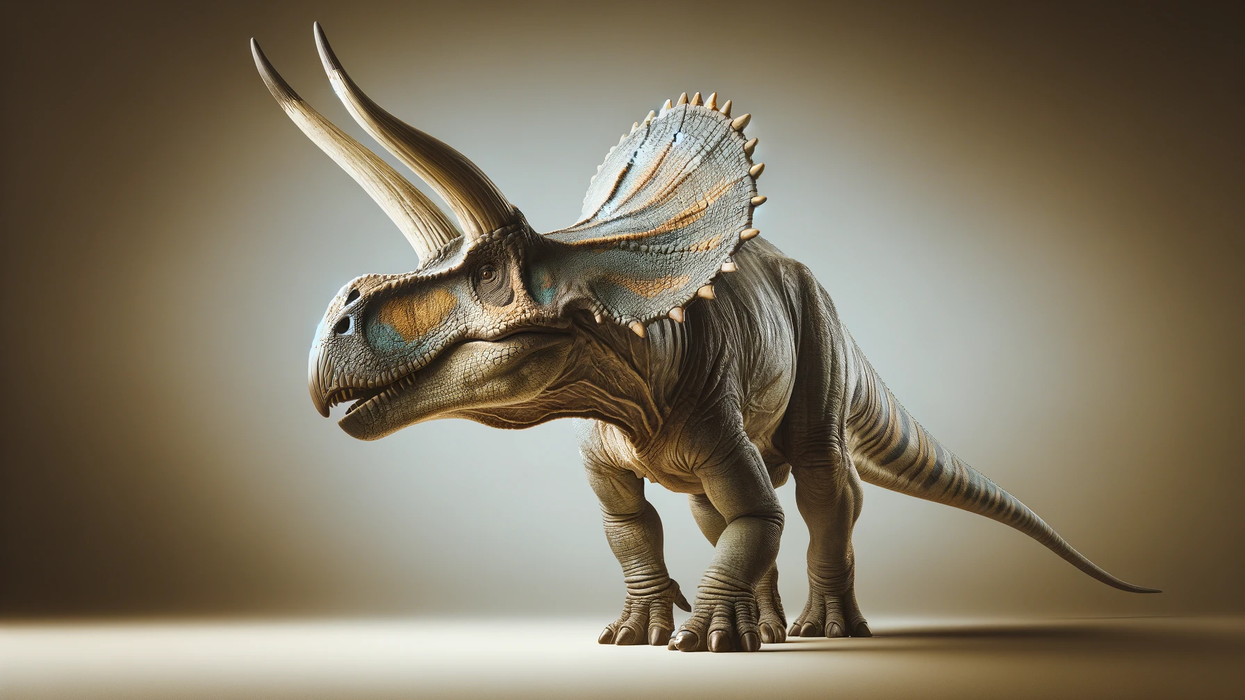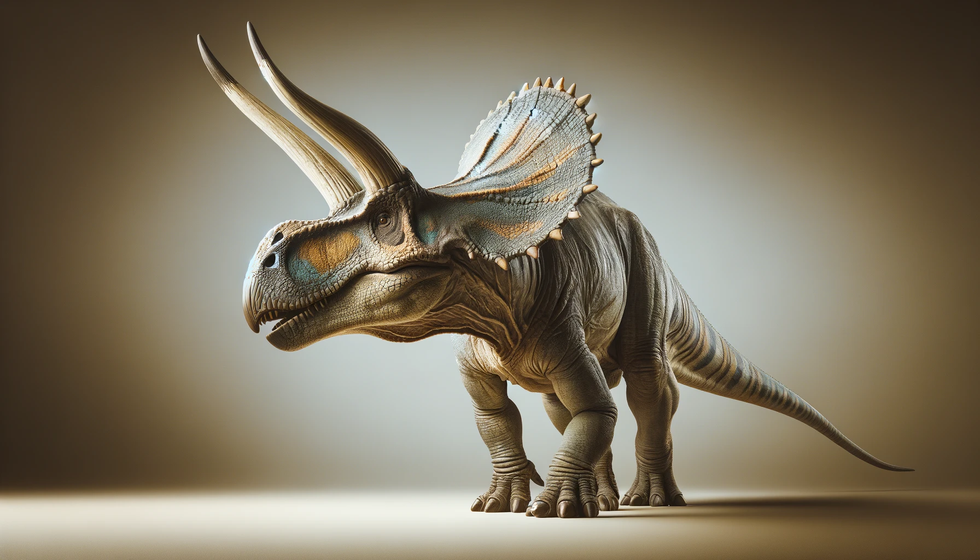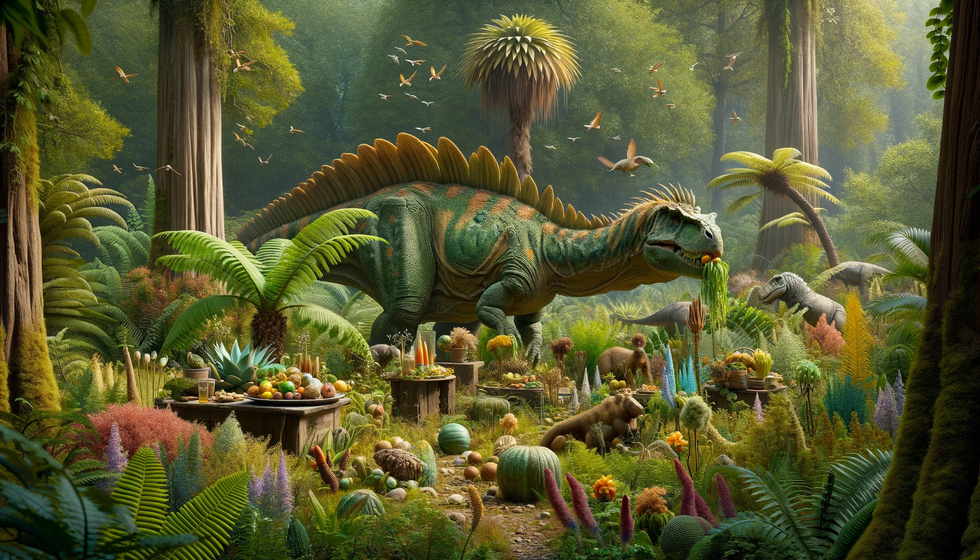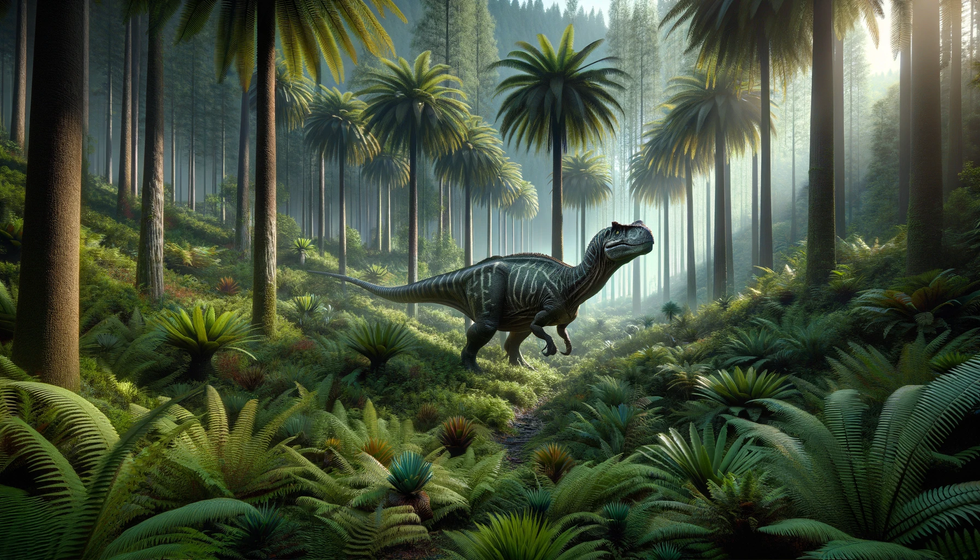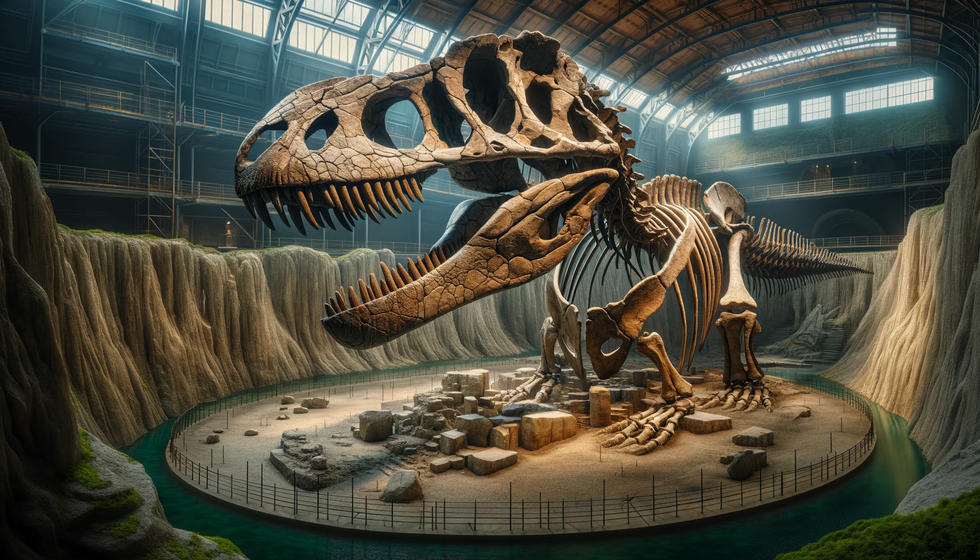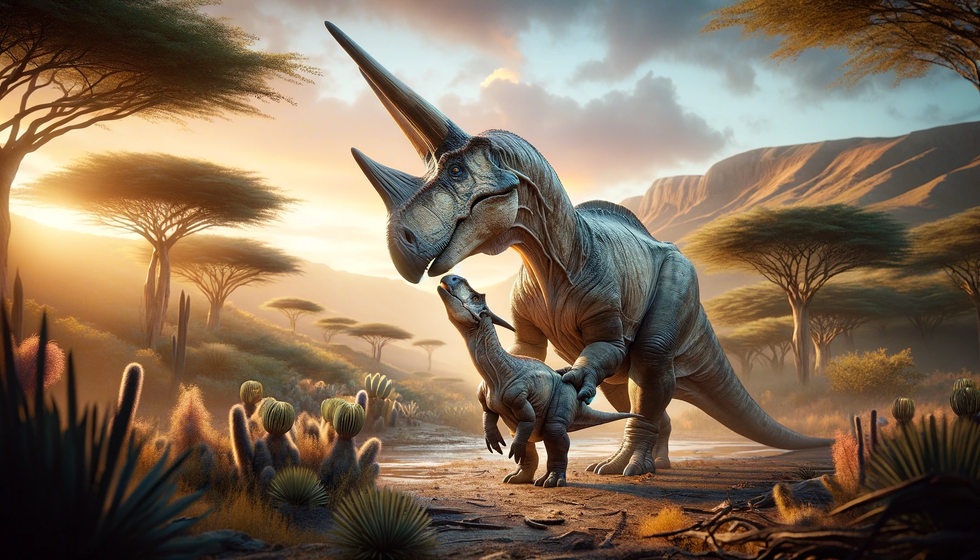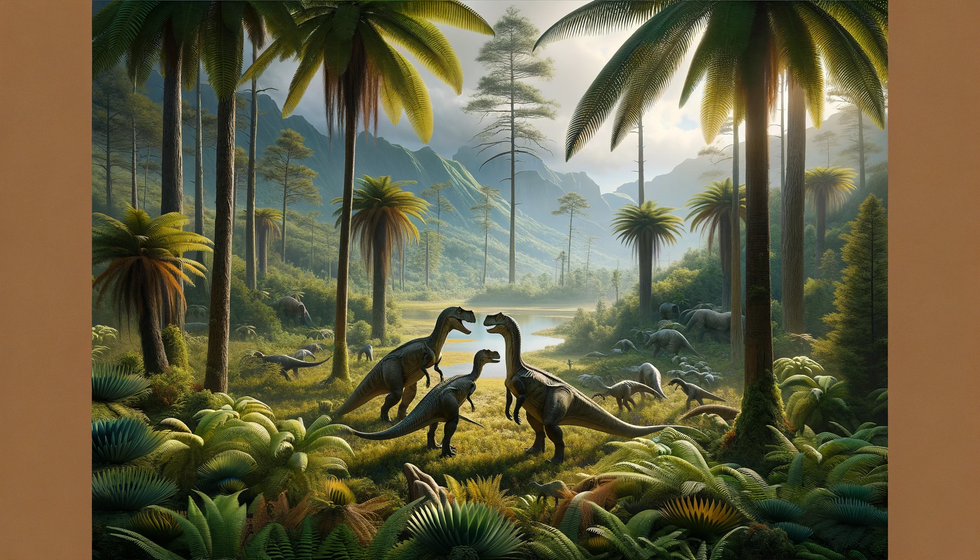The ceratopsid dinosaur, Einiosaurus procurvicornis stood out among Cretaceous dinosaurs with its unique downward-curving nasal horn and pronounced frill, a configuration, unlike the usual pointed horns of its relatives. Living approximately 74 million years ago, these herbivorous giants made their mark on history, leaving behind fossils that paint a picture of their existence.
Fossil sites such as the Two Medicine Formation in Montana, which is one of the numerous sites in the region that have produced horned dinosaur fossils, hold key insights into the lives of these creatures. Notably, paleontologists have discovered numerous nasal horns of the Einiosaurus, including those that display how the nasal horn developed over an individual's lifetime.
Reconstructing the life of the Einiosaurus involves piecing together evidence from these fossils. Prominent supraorbital horns and rough bone masses from skull remains have led to conclusions about their physical appearance. Initially, separated core halves of horns indicate a unique growth pattern in these dinosaurs.
Subsequent research invariably provides glimpses into the dinosaur bone beds and other significant sites, where the Einiosaurus fossils, representing some of the few that detail the evolution of the nasal horn, can be found.
It was learned that the adult horns of the Einiosaurus, potentially used for display or defense, were robust structures, with some even resembling large curved spikes projecting from their skulls.
Despite the wealth of knowledge gained, paleontologists acknowledge that too few fossils exist to understand fully the variations within the species. However, every new discovery, including further adult skulls unearthed from these bone beds, contributes valuable information to the narrative of the Einiosaurus, enhancing the human understanding of the upper Cretaceous Period's biodiversity.
The Einiosaurus was not the largest of its kind, weighing about 2,866 lb (1,300 kg), yet it lived a life significant enough to leave a lasting fossil record.
While the prominent forward and downward curving nasal horn found on the Einiosaurus remains its most distinguishing feature, even this was only a small contribution to the overall complexity of dinosaur lives during their reign.
Einiosaurus Interesting Facts

How do you pronounce 'Einiosaurus'?
Einiosaurus is pronounced as 'Eye-nee-oh-saw-rus'.
What type of dinosaur was an Einiosaurus?
The Einiosaurus was a type of ceratopsian dinosaur, specifically belonging to the family Ceratopsidae and the subfamily Centrosaurinae, distinguished by its prominent forward curving nasal horn.
In which geological period did the Einiosaurus roam the Earth?
The Einiosaurus lived in the Late Cretaceous Period (100.5-66 million years ago).
When did the Einiosaurus become extinct?
The Einiosaurus became extinct during the Late Cretaceous Period, specifically in the Campanian stage, which dates to about 74.5 million years ago.
Where did the Einiosaurus live?
The Einiosaurus lived in what is now northwestern Montana, USA. Its fossils have been found exclusively in the Two Medicine Formation of Montana.
What was the Einiosaurus's habitat?

The Einiosaurus likely inhabited semi-arid regions with grasslands likely dominating the landscape.
Who did the Einiosaurus live with?
This dinosaur coexisted with a diverse array of species, including the basal ornithopod Orodromeus, hadrosaurids like the Hypacrosaurus and the Maiasaura, other centrosaurines such as the Brachyceratops, the Stellasaurus, the leptoceratopsid Cerasinops, ankylosaurs Edmontonia, Euoplocephalus, and the tyrannosaurid Daspletosaurus, which was a predator of ceratopsians.
How long did an Einiosaurus live?
The lifespan of the Einiosaurus is not precisely known.
How did the Einiosaurus reproduce?
Like other dinosaurs, the Einiosaurus would have likely laid eggs, but specific reproductive behaviors are not well documented.
Einiosaurus Fun Facts
What did the Einiosaurus look like?
The Einiosaurus had a moderately large skull frill and forward curving nasal horn. Its adult horns resembled large curved spikes sticking out from its face.
How many bones did an Einiosaurus have?

The precise number of bones in the Einiosaurus is currently undetermined, and further research is necessary to establish a definitive count.
How did the Einiosaurus communicate?
While specific communication methods are not definitely known, they may have used visual signals facilitated by their frills and horns, as well as vocalizations.
How big was the Einiosaurus?
An adult Einiosaurus likely reached lengths ranging from around 15 ft (4.5 m) to 20 ft (6 m) and approximately 6.6 ft (2 m) at the hips.
How fast could an Einiosaurus move?
The locomotive capabilities of the Einiosaurus are currently not well documented; as a substantial quadrupedal dinosaur, it is unlikely that it was swift. To ascertain more about its speed, more research would be needed.
How much did an Einiosaurus weigh?
This Einiosaurus weighed approximately 2,866 lb (1,300 kg).
What were the male and female names of the Einiosaurus?
There aren't specific names for the sexes of Einiosaurus.
What would you call a baby Einiosaurus?

A baby Einiosaurus might be called a hatchling or juvenile.
How aggressive were the Einiosaurus?
The Einiosaurus was a herbivorous ceratopsian dinosaur, and its physical adaptations were primarily for feeding on plants. The forward-curving nasal horn and the spikes on its frill could suggest that it had the means to defend itself aggressively if necessary, possibly against predators or rivals within its own species.
Did You Know…

The term 'buffalo lizard' is indeed a reference to the genus name Einiosaurus, which is derived from the Blackfeet Indian word 'eini' for buffalo and the Latinized Ancient Greek 'sauros' for lizard. The specific name 'procurvicornis' means 'with a forward-curving horn' in Latin.
The Einiosaurus procurvicornis is distinguished by its forward-curving nasal horn, a feature that sets it apart from other ceratopsians. The discovery of fossils in three dinosaur bone beds within the Two Medicine Formation has been crucial for studying the species' behavior, ecology, and evolutionary significance.
Fossils of the Einiosaurus have been found in the Two Medicine Formation of Montana, dating to the mid-late Campanian stage of the Late Cretaceous Period, about 74.5 million years ago. At least fifteen individuals of varying ages are represented by three adult skulls and hundreds of other bones from two low-diversity, monospecific bonebeds.
These bonebeds suggest that the Einiosaurus may have been a herding animal, similar to modern-day bison, as opposed to the more solitary lifestyle inferred for some other horned dinosaurs like the Triceratops.
The nasal horns of the Einiosaurus are distinctive in their morphology, being transversely flattened and having a long base from front to rear. Adult horns are much more procurved than any nasal horn found in Centrosaurus beds, and they are more laterally compressed compared to the more oval cross-section of the Centrosaurus horns.
The discovery of these fossils, particularly the skulls with their intricate frills and dramatic horns, has been instrumental in reconstructing the appearance of the Einiosaurus and hypothesizing about their lifestyle and behavior. The density and variety of fossils in the area provide an invaluable dataset for understanding the Late Cretaceous Period and the evolutionary history of ceratopsians.
FAQs
What era did the Einiosaurus live in, and where has it been found?
The Einiosaurus lived during the Upper Cretaceous Period, specifically in the late Campanian stage, approximately 74-70 million years ago. This time frame places it towards the end of the Mesozoic Era, just a few million years before the mass extinction event that wiped out the non-avian dinosaurs.
Fossils of Einiosaurus have been predominantly found in the Two Medicine Formation, a geologic formation located in northwestern Montana, United States. This formation has proven to be a rich source of ceratopsid dinosaur remains, including those of the Einiosaurus.
The Two Medicine Formation is known for its extensive dinosaur bone beds, which have provided significant insights into the life and environment of the Late Cretaceous Period in North America,
The Two Medicine Formation was part of a vast coastal plain that existed in what is now Montana during the Late Cretaceous. The climate of the region was seasonal, warm, and semi-arid, supporting a diverse ecosystem.
How did the distinctive nasal horn of the Einiosaurus develop?
The distinctive nasal horn of the Einiosaurus developed as an ontogenetic feature, meaning the nasal horns gradually change in shape and size as the Einiosaurus ages. In juveniles, the horn started smaller and less curved, and as the Einiosaurus grew, the horn became larger and more pronouncedly curved forward.
This development is evidenced by fossil records that show variations in horn structure among specimens of different ages.
Paleontologists have referred to eight nasal horns of the Einiosaurus from two bonebeds, which have helped to show how the horn developed during the growth of the animal. The initially separated core halves of the horn fused from the tip downwards and joined into a single structure on the midline.
In the subadult stage, the core still showed a suture, indicating the growth pattern of the horn as the animal matured.
The nasal horn of the Einiosaurus is transversely flattened and has a long base from front to rear. Adult horns are much more procurved than any nasal horn found in Centrosaurus beds, and they are more laterally compressed compared to the more oval cross-section of the Centrosaurus horns.
This forward curvature of the nasal horn is thought to have ultimately evolved to touch upon itself to form the nasal bosses that are present in other related centrosaurine dinosaurs.
What did the Einiosaurus primarily feed on, and did it have any predators?
The Einiosaurus was a herbivorous dinosaur that primarily fed on plant matter. Its beak and tooth structure suggest that it was well-adapted for clipping and chewing tough, fibrous plants that were common in its ecosystem. Given the types of flora present during the Late Cretaceous, its diet likely included ferns, cycads, and conifers, among other vegetation.
As for predators, the Einiosaurus and other herbivorous dinosaurs of the period faced threats from carnivorous theropods. Large predators such as the Tyrannosaurus and smaller but agile hunters like the raptors would have posed significant dangers to these ceratopsids.
Natural defenses like their distinctive horns and large frills could have been used to fend off these threats, and moving in herds may have further enhanced their chances of survival against predators.
Are there any notable differences between Einiosaurus fossils and other ceratopsid fossils?
Yes, there are several notable differences between the Einiosaurus fossils and those of other ceratopsid dinosaurs. The most distinctive feature of the Einiosaurus is its forward-curved nasal horn, which differs significantly from the straighter and more upright horns observed in other ceratopsids like the Triceratops and the Styracosaurus.
The skull of the Einiosaurus is also characterized by a moderately large frill, which is less expanded and ornate than those of some other ceratopsids.
The Einiosaurus fossils also exhibit variability in the shape and size of their horns and frills, indicating a possible diversity in gender differences or age-related characteristics within the species. Furthermore, the fossils show a different arrangement of epoccipitals, which are bony projections on the frill's edge that vary among ceratopsids and are valuable for species identification.
In addition to these features, the pattern of growth of the nasal horn, as the Einiosaurus matured, is quite unique among ceratopsians. The horn starts as a small upward-facing protuberance in juveniles and progressively becomes more pronounced and curved as the dinosaur ages.
These differences in morphology highlight the richness of the ceratopsid clade and contribute to the human understanding of the evolutionary pathways that these dinosaurs took.
The Einiosaurus, notable for its forward-curving nasal horn, was a distinctive ceratopsian that lived in Late Cretaceous North America. Its unique features contribute to the understanding of the diversity within the horned dinosaurs.
Fossils from Montana's Two Medicine Formation have proven crucial in revealing details about ceratopsian life, allowing researchers to delve deeper into the dynamics of ancient ecosystems where these impressive creatures once thrived.
Related Articles Around the Web

